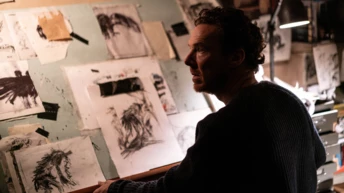
Save this storySave this storySave this storySave this story
There’s a real sense of satisfaction to be gleaned from experiencing “Fire of Wind,” the initial full-length film by Portuguese filmmaker Marta Mateus, and discovering something beyond the conventional depiction of performers acting. The majority of productions tend to follow a similar pattern, at least structurally. The screenplay takes precedence, the actors embody the script in a naturalistic manner, emphasizing their characters’ internal states, and the directors document the performances—sometimes with creativity, other times less so—in a fashion that puts the spotlight on the dramatic narrative, as if the film were a theatrical production that has been removed from the stage. “Fire of Wind” diverges from this norm significantly: while it undoubtedly presents a narrative involving believable human conduct and features a cast of actors throughout, this cast is primarily composed of inhabitants from the movie’s southern Portuguese setting, individuals without formal acting experience. Their performances don’t aim for the nuanced depiction of motivations and behaviors that typically defines acting in film. They’re delivering lines and executing actions rather than cultivating characters; their mere corporeal presence takes precedence, and their roles lean more towards the archetypal than the psychological. Moreover, the core of their scenes is as contingent on Mateus’s visuals as it is on the unfolding action.
The dramatic tension in “Fire of Wind” originates from observations akin to those found in documentaries. The film unfolds entirely on a sprawling rural property that includes a vineyard. Laborers—both women and men of various ages—harvest bunches of grapes, placing them in plastic containers before transferring the contents to a tractor’s loading mechanism. When Soraia, a young female worker, receives criticism from a supervisor, she departs in a huff. Deep within the vineyard, she picks two more clusters of grapes and sustains a cut to her hand. A bull breaks free—possibly drawn to her blood, although it’s conceivable that the estate owner deliberately released it—and inflicts serious harm on a worker. Soraia and the others ascend into trees to evade the rampaging animal, and while positioned aloft among these ancient-looking boughs, they recount their personal histories and experiences, exchanging photographs and cherished items, and delving into local customs and legends.
Except for moments when the characters are actively engaged in working among the grapevines, the performers’ portrayals are generally static, and their delivery is theatrical. Nonetheless, this deliberate style isn’t merely superficial—it transforms “Fire of Wind” into an inventive and deeply ingrained piece of political filmmaking. The individuals involved are relating more than fragments of their lives; they are providing articulation to the entire scope of modern Portuguese history as it has impacted them and their families, encompassing World War I, the Salazar regime and the protracted colonial conflict of the sixties and seventies, and, in 1974, the Carnation Revolution and the advent of democracy. They commence by narrating the exploitative employment practices that have perpetuated poverty and desperation among the workers. However, a crucial moment arises early on when an older woman, upon hearing the catalogue of complaints against landowners and supervisors, observes, “The more we talk about them, the more we neglect ourselves.” This remark ignites the characters’ introspective musings, their detailed examination of the mythopoetic enchantment of their proximity to the land, their profound unity with one another, and their passionate devotion to their individual and shared past.
There exists a sensation of repetition in the heightened and mannered language with which Mateus directs her cast to bear witness, and this impression is amplified by the picturesque compositions that frame the speakers. “Fire of Wind” distinguishes itself as a cinematic experience primarily driven by visuals. Its meticulous engagement with the interplay of light and shadow, the textures of faces and tree bark, the verdant foliage, and the lay of the land stands out as one of the most conscientious and daring I have encountered. (Mateus and Vítor Carvalho shared the responsibility of cinematography.) Though “Fire of Wind” deviates considerably from other recent releases, it nonetheless evokes a distinguished lineage within political filmmaking. Mateus’s approach to the delivery of text by non-professional actors echoes the methodologies employed in films by Jean-Marie Straub and Danièle Huillet, while her allegorical, earthy exploration of the lives of the marginalized classes through history pays homage to the Portuguese filmmaker Pedro Costa. (In conjunction with the opening of “Fire of Wind” at Anthology Film Archives, Mateus has curated a program of interconnected films, including those by Costa, Straub and Huillet, as well as numerous other prominent figures, such as Chantal Akerman, Manoel de Oliveira, and Robert Bresson.)
Within “Fire of Wind,” Mateus navigates her unique trajectory through these commanding influences, notably by identifying her distinct sense of physical drama amidst the abstract forces of political and economic authority amid the allure and splendor of nature. While the workers, nestled within the trees, maintain their stillness, the bull’s foreboding, wandering presence imbues that frozen calm with a clear purpose and renders moments of shifting and even leaping from one branch to another fraught with suspense. Eventually, the locals re-engage in activity on the ground: the workers initiate a strike, paramilitary forces patrol the premises with firearms, and a young soldier, injured in combat, stands armed in solitude. This unfolding action isn’t merely a sequence of plot elements; instead, it entails a stratification of time, wherein individual recollections, public occurrences, and communal experiences converge within the very locale where they transpired. At its most potent and intimidating, the film is also imbued with an aura of mystery and marvel.
The element that distinguishes “Fire of Wind” from the superficial topicality often mistaken for political cinema within the art-house sphere—whether domestically (exemplified by “Eddington”) or abroad (as seen in recent works by Radu Jude)—lies in its metapolitical essence. For Mateus, as for the filmmakers held in high regard within her personal canon, the conflicts at hand are inextricably rooted in local and national history, as well as in profound reservoirs of experience that are too readily dismissed as mere folklore, from which individual identity and collective identification spring forth. In “Fire of Wind,” mirroring the films featured in Mateus’s Anthology series, politics and aesthetics are inseparable. These filmmakers aspire to a holistic perspective, wherein meticulous scrutiny of social specifics merges with echoes and implications of overarching forces at play during moments of crisis.
This aesthetic is inherently political—a method designed not only as a counterpoint to systems of injustice and exploitation but also to the triviality of mainstream political discourse and to the reductive rhetoric of commercial cinema, which, while feigning engagement with politics, actually exploits and diminishes it. This cohesion of style and subject matter, of form and concept, represents both an artistic asset and a potential pitfall, both artistically and politically. On occasion, even the most refined and innovative cinematic techniques, along with the ambitious concepts that accompany them, can risk becoming as routine and as comfortable as the accolades that greet them.
Within this framework of perpetual resistance, a distinct art-house aesthetic runs the risk of evolving into a form of political dogma and creating a circular pattern of critical evaluation: as proponents of a shared political viewpoint endorse a specific style, adherents of that style presume its underlying politics, and the filmmakers themselves become trapped within a self-reinforcing loop of content and form. (This tendency has been observed even among some of the filmmakers selected by Mateus.) The ultimate outcome may resemble a form of pandering to a niche audience, much like the allure of blockbuster films. The foremost political filmmakers, by challenging not only the self-satisfaction of conventional political filmmaking but also the ideological comfort zones of art-house viewers, breathe new vitality into their own artistic endeavors. That’s precisely why the ambitious artistry of “Fire of Wind”—a daring initial feature that also serves as Mateus’s personal engagement with the cinematic heritage that inspires her—has me eagerly anticipating her future endeavors. ♦
Sourse: newyorker.com







